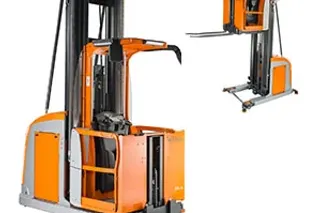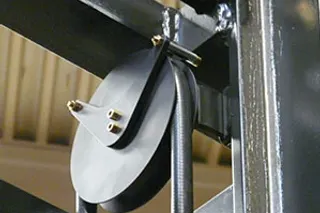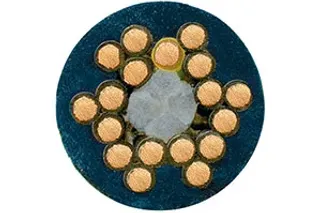Change Language :
Chain-suitable and "roller-suitable" cables for an order picker
chainflex® cable in the lift frame of the EK-X order picker
The designers at Still GmbH used a chainflex® cable to guide and signal cables to the cabin of the EK-X order picker with multiple guide rollers. The cable was originally developed for use in energy chains, but after tests were conducted by igus® and Still, it was discovered that the cable can function effectively in roller guides.

Many operators of logistics centers, distribution centers and warehouses use forklifts, tractors and order pickers from Still GmbH. The enterprise is part of the Kion Group, which is the second largest forklift manufacturer in the world.
The EK-X vertical order pickers are particularly impressive devices from Still’s product range. The order pickers drive to the pallets in the narrow aisles of a warehouse, where the driver can remove individual boxes. The order pickers are capable of reaching heights up to 39 feet and are designed with modularity. Customers can select different cabs, lift masts, control panels and battery systems. Custom-designed options are also available.

Real high-performance devices in the narrow-aisle warehouse: The vertical order pickers of the EK-X type series allow reaching heights of up to 39 feet. The driver also moves upward.
Detailed design
The order pickers are developed and produced at the Kion Warehouse Systems GmbH plant in Reutlingen. Every year, roughly 2,000 warehouse devices are created with extreme care and precise detail.
The purpose of the collaboration between Kion and igus® was to optimize the lift frame of the EK-X. The guidance of the electric and hydraulic cables in the lift mast had to be redesigned to save more installation space. “Originally, we used a polygon element on the deflection points that formed a semicircle of small rollers. However, due to the smaller installation space in the new mast, there had to be a solution with one roller,” said Achim Schwarz, product manager at Still GmbH.

The energy cables and signal cables in the lift frame, which are up to 46 feet in length, are guided via guide rollers and move each time that the mast is lifted or lowered.
The “corkscrew” failure
Even with small order pickers, Still GmbH uses this deflection principle and it has proven to be effective. The lateral guide of the roller in the EK-X series was slightly enhanced due to the greater cable lengths, but tests quickly showed that the solution wasn’t successful overall. Volker Haspel, responsible for electrical engineering at Kion said, “The cables that we used twisted and looked like a corkscrew. Shortly after, they failed in the test.”
During this development stage, Kion contacted cable experts at igus® because they have helped customers solve similar problems. Andreas Muckes, chainflex® product manager said, “When we developed our first e-chains®, we recognized that most standard cables on the market did not last long. This was the starting point for our cable product line.”

The chainflex® cables are braided in bundles and designed for use in energy chains. In bending processes, they do not develop “corkscrews” and are therefore chain-suitable without restrictions.
A look inside the cable
igus® developed the chainflex® product range, which differed from standard industrial cables. Standard cables are designed in layers, where the core of the cable has a relatively long pitch in multiple layers and is fitted with a jacket extruded as a hose. When the cables in the energy chain move, the cores in the inner radius are compressed and the cores in the outer radius are elongated. This causes extremely high tensile forces and shear forces on the cores. When these forces transmit in the cable, the construction of the core is destroyed. This results in the deformation of the cable, which causes the “corkscrew” to occur and ultimately leads to core breakage.
Knowing this, igus® developed cables based on a completely different construction principle. igus® braids cable cores into bundles with a small pitch length around a core element. The core element is not used as a filler, rather, it is designed as a strain relief element. The appearance of the cable is highly similar to a steel rope. For additional support, a jacket is extruded under pressure to guide the wires in the longitudinal direction. This design of chainflex® cables creates less force to occur in the cable, and keeps the structure intact.
Are chain-suitable cables also "roller-suitable"?
The structure of chainflex® cables is more complex, meaning manufacturing the cables requires more effort, but the detail pays off in the long-run. The cores and the entire cable are uniformly stressed during bending processes, thus avoiding failure. Andreas Muckes said, “We have never seen a cable braided in bundles ‘corkscrew,’ so this has become one of our most important design principles.”
In the igus® test lab and Kion’s facilities, preliminary trials were conducted to see if the chainflex® cables are “roller-suitable.” Developers from the Mechanical Engineering organization were included in the study. Matthias Fohrer of Mechanical Engineering said, “Testing such cables is definitely a complex task. They execute relative motions in the lift frame and high dynamics occur when moving the order picker. You have to take the tensile force that occurs into account, as this is different than the situation with energy chain cables.” igus® experts were appreciative that the Kion designers were so intensively involved in solving this issue. “There are really not many companies that would do this,” Muckes said.

In the development phase, Kion worked closely together with igus®. Ultimately it was shown that: the chainflex® cables are not only chain-suitable, but also roller-suitable. Left to right: Andreas Muckes, chainflex® product manager, Achim Schwarz, Very Narrow-Aisle Devices (VNA) product manager at Still GmbH, Matthias Vohrer, Design – Mechanical Engineering at Kion Warehouse Systems, igus® sales consultant Michael Fuchs, and Volker Haspel, Design – Electrical Engineering at Kion Warehouse Systems in Reutlingen, Germany.
New standard for lift frame cable
The test results proved that the cables braided in bundles are “roller-suitable.” The special materials of the jacket also increase durability. It was demonstrated that the shape of the roller does not have a direct influence on service life. Thus, it was an easy decision for the Still designers: the chainflex® cable with braided bundles and a TPFE jacket was used in the lift frame of the EK-X. Though the chainflex® cables are designed in blue, Still received a customized black cable to match the lift frame and hydraulic hose.
Well-designed, thoroughly tested
The cables that are used in the order pickers are between 14.8 and 52.5 feet in length. Undoubtedly, they are put under high stress. Many applications are in continuous use, meaning that the lift frame is always in motion. The chainflex® cables move under these conditions just like they move in thousands of energy chain applications. With this cable, Still has found a solution for a task that arose through the altered geometry of the lift frame and guide roller. The cable specialists at igus® have also gained an insight of knowing their cables are not only chain-suitable, but also effective in roller guides.